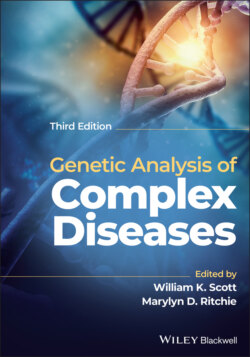Читать книгу Genetic Analysis of Complex Disease - Группа авторов - Страница 55
Susceptibility Versus Causative Genes
ОглавлениеAs the study of common and genetically complex human diseases identifies the significant contribution of heredity in their development, it is likely that more genes or genetic risk factors will be found to affect susceptibility to disease rather than the more traditionally considered causative genes. Historical successes in the localization of genes have been with diseases whose mode of inheritance is known (as illustrated above). These disorders are often highly or completely penetrant and are due to a defect in a single gene, yet these Mendelian disorders are often relatively rare in the population. However, in recent years, genomic research has uncovered genetic risk factors for many diseases that were suspicious for genetic etiology but were unexplained by traditional Mendelian cause and effect. Some of the most common and deadly diseases of society, such as cardiovascular disease, cancer, and obesity, have significant genetic components that are evident from non‐random family clustering. These diseases are termed “complex” because they are likely due to the interaction of multiple factors, both environmental and genetic. Susceptibility genes for such complex disorders are substantially harder to identify than genes responsible for Mendelian disorders.
A well‐characterized example of a susceptibility locus is that of the apolipoprotein E (APOE) gene and Alzheimer disease (AD). The APOE gene on chromosome 19 has three different alleles, scored as 2, 3, and 4, which occur with frequencies 6%, 78%, and 16% in most European populations, respectively (e.g. Saunders et al. 1993). These alleles differ in their DNA sequence by only one base at codons 112 and/or 158 (Figure 2.11). The APOE 4 allele increases risk and decreases age of onset in familial and sporadic late‐onset AD and early‐onset sporadic AD. The 2 allele has been shown to be protective to some extent for risk to develop AD (Corder et al. 1994, 1995a,b; Farrer et al. 1997). It is important to note that for APOE and AD, the 4 allele is not by itself sufficient or necessary for the development of AD but has been shown to be associated with increased susceptibility to AD.
Table 2.4 Salient features of human repeat expansion diseases.
| Condition | Gene symbol | Repeat type | Repeat localization | Repeat number abnormal range | Inheritance pattern | Clinical features |
|---|---|---|---|---|---|---|
| Fragile X syndrome | FRAXA | CGG | 5’ Untranslated region | 200–1000 (premutation range of 52–200) | X‐linked | Moderate to severe mental retardation, behavioral abnormalities, macroorchidism, large ears, and prominent jaw |
| Huntington disease (HD) | HD | CAG | Open reading frame | >36 (premutation range 27–35) | Autosomal dominant; expansion more common in paternal allele | Choreiform movements, dystonia, psychiatric illness, cognitive decline, dementia |
| Myotonic dystrophy | DM1 | CTG | 3’ Untranslated region | Mild: 50–150 Classic: ~100–1000 Congenital: >2000 | Autosomal dominant; expansion more common in maternal allele | Weakness, myotonia, ptosis, cataracts, cardiac arrhythmia; endocrine abnormalities, frontal balding |
| Friedrich Ataxia | FXN | GAA | Intron | 66–1700 uninterrupted repeats (premutation range of 34–65 uninterrupted repeats) | Autosomal recessive | Ataxia, sensory loss, weakness, diabetes mellitus, cardiomyopathy |
Figure 2.11 Single base pair changes in exon 4 of APOE define the 2, 3, and 4 alleles at this locus.
(Source: Modified from Pericak‐Vance and Haines (1995).)
